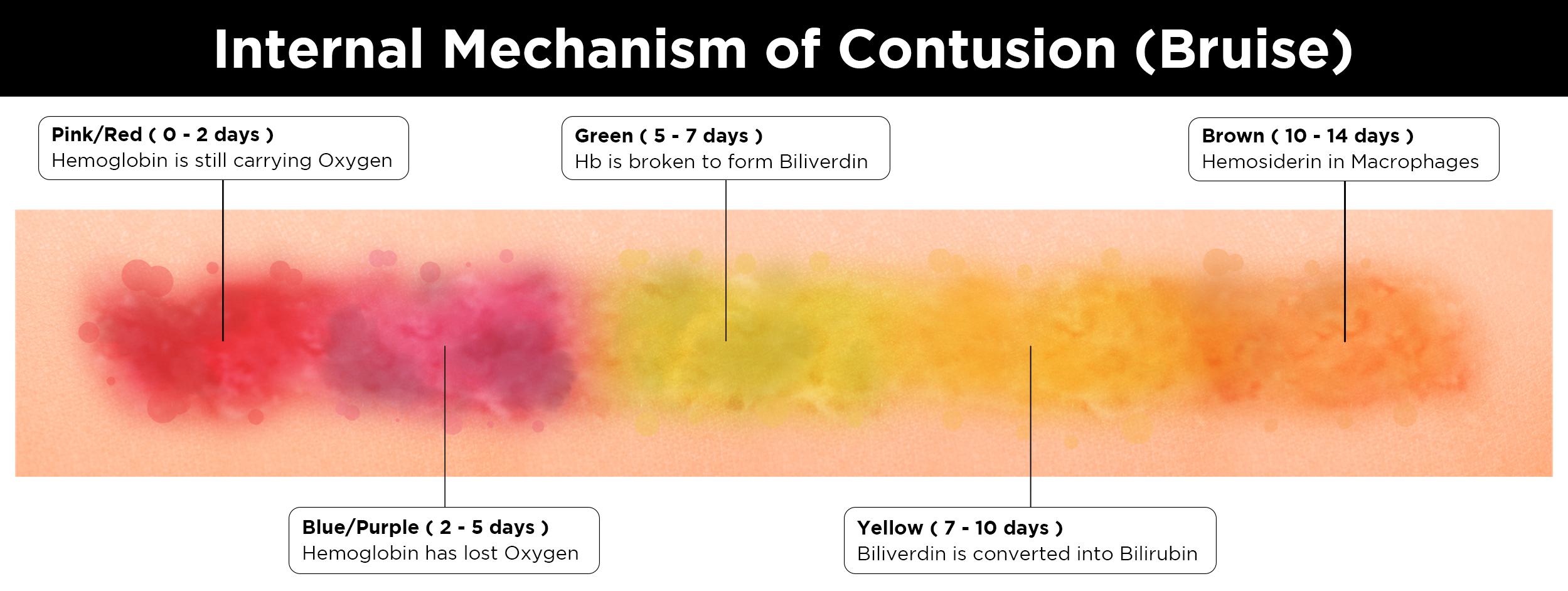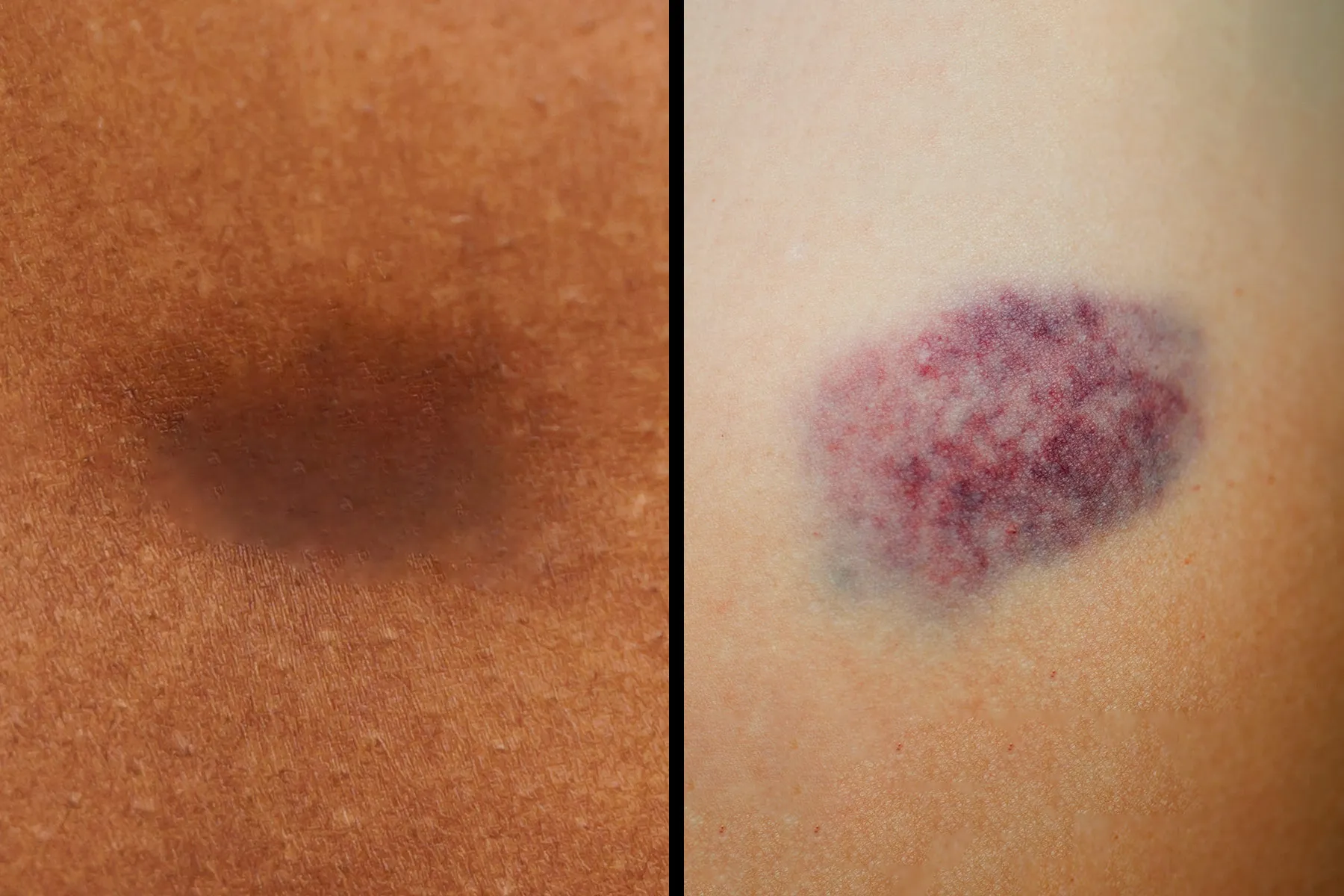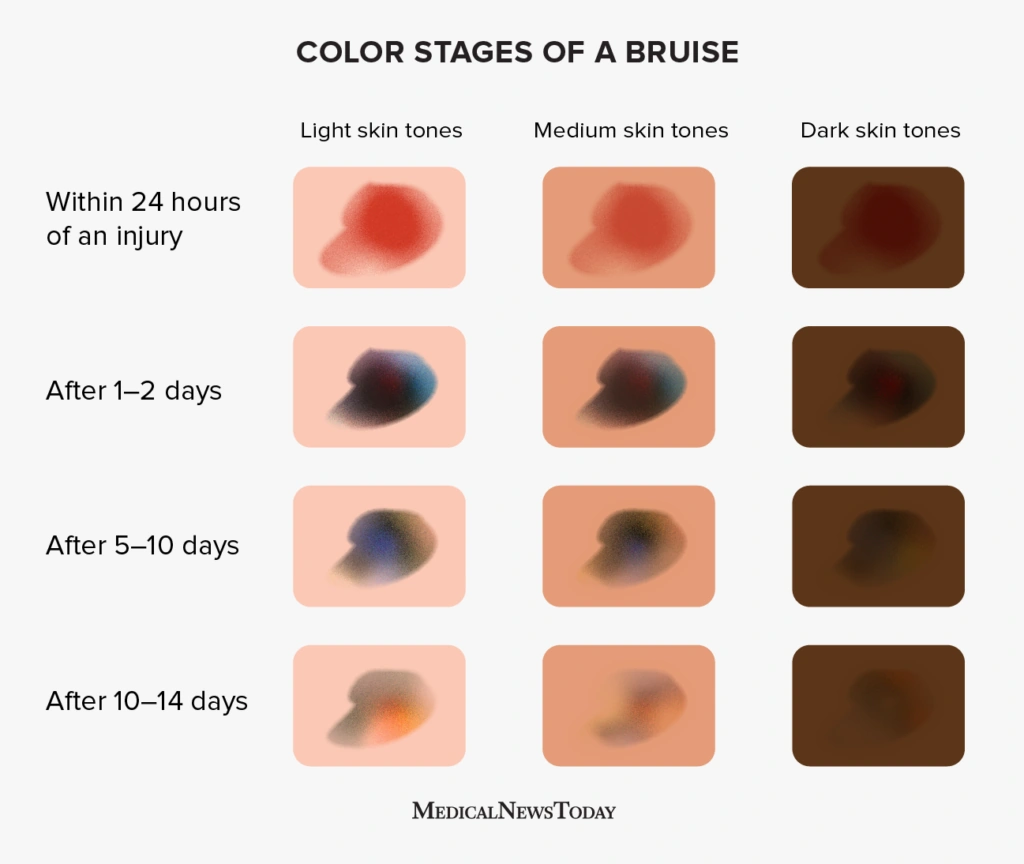Let’s Peek Under the Skin
Okay, quick question—when was the last time you stubbed a toe, bumped an elbow, or whacked your knee against something hard? Unless you’re part cat (jealous if so), you probably can’t remember. But I’m betting you’ve caught yourself rubbing an achy bruise, staring at it, and wondering, “How old is that thing, anyway?” I do it about once a month—clumsy club, anyone?
So, let’s get curious. Bruises aren’t just badge-of-honor splotches; they’re little time machines, shifting through colors as your body heals. And yes… people think you can read the age of a bruise based on color. But is that true? Or just another medical myth we’ve all accepted along with the “wait thirty minutes after eating to swim” rule?
Rather than just dropping textbook lists, I want to have a chat—the kind you’d have with a friend over coffee. The science, the messy facts, the real-life stuff. Ready?
Why Do Bruises Even Change Colors?
It’s Basically DIY Art (But Less Fun)
Alright, science time (don’t worry, I’ll keep it simple). When you bang yourself, blood vessels under your skin break. Blood leaks out, but there’s nowhere to go, so it gathers in a pool. No open wound, just a “subdermal puddle.” Your body rushes in to clean things up, and as it does, the mess changes color—literally. Kind of like a weird magic trick, except the spell is “ouch.”
The transformation isn’t random: it’s your body recycling red blood cells and sweeping away the debris. Each color actually has a story, and clues for you to follow. Much cooler than you probably thought, right?
Anecdote Alert
(One time, I woke up with a wild blue bruise on my thigh. Zero memory of what caused it. Took pictures every morning, half just to figure out if I was getting mysterious nighttime ninja fights. Spoiler: sadly, no. But it was fascinating watching the color parade march by.)
From Red to Yellow: The Colorful Stages
What Do the Shades Mean?
This is where the “age of bruise based on color” rumor really kicks in. Does the color actually tell you when you got hurt, like some sort of skin clock? Sort of…but it’s more of a guessing game than an exact science. Here’s why:
- How hard you smacked yourself matters.
- Where on your body? Shin versus arm? Totally different timeframes.
- Skin tone and age. (My mother’s bruises hang around way longer than mine. Something about thinner skin and slower healing.)
Table: The Classic Color Progression
| Rough Time | Color | What’s Happening? |
|---|---|---|
| 0-1 days | Red, reddish-purple | Fresh blood, lots of oxygen in it. Looks bright and dramatic. based on breakdowns of bruise color |
| 1-2 days | Blue or purple | Blood loses oxygen, starts to change. Your bruise gets moodier. according to health experts |
| 5-7 days | Green | Hemoglobin (the red stuff) breaks down to biliverdin (the green stuff). Healing’s moving along. healfast explains this phase |
| 7-10 days | Yellow | Biliverdin turns into bilirubin. Almost there. Bruise may look gross, but it’s fading. |
| 10-14 days | Brownish, then fades | Everything’s getting cleaned up and reabsorbed… until poof, bruise is gone. |

Want more deep-dive on the healing process? The Age of bruising guide is a rabbit hole worth falling into—which I definitely did while writing this.
Does Color Really Reveal a Bruise’s Exact Age?
The Messy Truth (Don’t Shoot the Messenger!)
So, here’s the real talk: doctors, forensic scientists, even Sherlock Holmes wannabes—none of them can tell you the precise “birthdate” of a bruise by looking at the color. I know, disappointing! Turns out, that old “red is new, yellow is old” saying is only half-right.
The science is kinda wild. Research from 369 bruise photos (that’s a lot of bruises—imagine that slideshow) found the yellow color was most likely to show up after 18 hours—but sometimes it popped up within a day and sometimes took longer, especially in folks over 65. Blue, purple, and even red could hang around way longer than you’d expect. This forensic study was actually trying to help in cases of suspected child abuse… but what they learned is that bruise color isn’t a courtroom smoking gun. (Could be a reason Age of bruises forensic experts are so cautious.)
Adding to the drama? Kids’ bruises change color differently than adults. Young skin heals fast; old skin takes its sweet time. People with darker skin tones see fewer color changes—sometimes bruises look shadowy and deep red for a long time, and green/yellow might barely show at all. Everything from the thickness of your skin to the fat underneath changes the color timeline. Even certain health conditions and meds (blood thinners, I’m looking at you) can make bruises more unpredictable.

Real-life Story Pause
I remember my best friend’s toddler falling off a swing and getting this huge nasty bruise. It started purple, but within a day, it had this odd combo of yellow, purple, and brown—almost tie-dyed. The doc shrugged and just said, “That’s how kids’ skin does it. Looks wild, heals fast.”
So… Can Forensics Date a Bruise by Color?
The Courtroom Myth Gets Busted
Okay, let’s imagine you’re in a detective drama—dun, dun. You want to know if bruise color can pin down “when did the injury happen?” It’s tempting to hope the color line-up is like reading tree rings. But forensics? Not so fast.
If you peek at some Age of bruises forensic resources, you’ll see the advice is to never rely on color alone. Doctors and investigators have tried… and failed to date bruises to even within 24 hours by sight, getting it wrong more than half the time. In one systematic review, experts couldn’t even agree on what color means “new” vs. “old.” That’s why police and social workers look at the whole picture—story, timing, witness, and medical tests—rather than just what the bruise is broadcasting on skin TV.
I guess it’s comforting in a way? Your body is just too unique—color doesn’t rat you out as much as you’d think.
Quick Comparison
- Fresh red or purple? Could mean yesterday… or just a slow healing spot.
- Yellow or greenish? Might be healing fast (kids, young folks) or slow (older folks).
- Shadowy bruise that sticks around? Could be totally normal, especially if you’re anemic or bruising easily these days.
By the way, this is why forensic doctors are so careful when presenting opinions—they dive deep into context, not just color. Worth a look if you’re into the investigative side: Age of bruises forensic.
Bumps, Bruises, and When to Worry
What If Your Bruise Breaks the Rules?
Now, most bruises are like awkward guests: they show up uninvited, draw attention for a week or two, then quietly disappear. No big deal. But sometimes they really overstay their welcome.
- If you get a monster bruise from a tiny bump—especially if it happens a lot—consider mentioning it to your doc. (I did, and learned mine was thanks to low vitamin C. Ugh. Eat your oranges, people!)
- If a bruise doesn’t fade after two weeks—or turns a crazy pattern (like radiating out with swelling)—that’s worth a conversation, especially if you’re taking blood thinners or have blood-related issues.
- Sudden, massive unexplained bruising? Don’t play tough—just get checked out.
Personal Story
I once tried a new HIIT class. Loved it… until I noticed bruises blooming up and down my legs. Turns out, it was just my body adapting (and being a bit of a drama queen). They healed up with lots of rest and a little TLC, but it gave me a good excuse to treat myself to a rest day—permission granted if you need it, too.
Tracking Your Bruise: Is It Useful?
Oddly Satisfying, Actually
If you’re an amateur health detective (like me), snapping a photo every day can be kinda fascinating. You’ll start noticing patterns. Some bruises change colors following the so-called textbook—and some just do their own thing. Quick nerd tip: comparing bruises from year to year (yep, I do it) can actually reveal a lot about how your body’s healing rhythm changes with stress, sleep, or vitamins.
Got kids, play sports, or work out a lot? I recommend having that “is this healing normally?” conversation with your doc at least once. And if you want background reading, the Age of bruising explainer is gold.
Bruise Wisdom: Things to Remember
Spoiler—There’s No Crystal Ball
Let’s clear things up. The “age of bruise based on color” isn’t a science you can bet on. It’s more of a rough sketch—trends, not timelines. The real message? Your body’s in full healing mode, and every bruise writes a slightly different story on your skin.
- Red, purple, blue: Newish (days 0-5). But could last longer, especially on legs or with deep bruises.
- Green, yellow: Middle to late stages (5-10 days). Or faster if your body works quickly.
- Brown, fading: The end is near (10-14 days), though not every bruise follows the rules.
But hey, don’t worry about being “normal.” There’s a wild range of normal. And your skin (and how fast it recycles bruises) reflects your age, activity, nutrition, and even how often you run into furniture. (Shout-out to clumsy people—we see you!)
Wrapping Up: You and Your Bruises—Wiser Together
So here’s the scoop: every bruise tells a story, but the color isn’t a precise diary entry. The whole “age of bruise based on color” thing? Useful as a broad roadmap, but not a GPS. Don’t stress about the pigment parade or try to diagnose yourself based on shades alone. Notice what patterns your body follows. If something seems weird, get it checked. Most of all, trust your instincts… and maybe try to dodge that corner of the coffee table next time. (I say this as someone with five shin bruises as I write. Sigh.)
Your skin’s got your back, even if it’s a little dramatic about healing. Embrace the color shifts, marvel at your body working overtime… and remember: it’s okay to slow down, rest, and heal. If you ever want to geek out more, don’t forget about the amazing resources at Age of bruising and the detailed world of Age of bruises forensic. They’ll satisfy your inner health detective—and maybe help you worry a little less next time you spot a shiner.
Now, tell me… what’s your weirdest bruise story? I’ll go first: walked into a glass door, got a bruise on my forehead, and pretended it was a “third eye” for a week. Your turn!


















Leave a Reply
You must be logged in to post a comment.